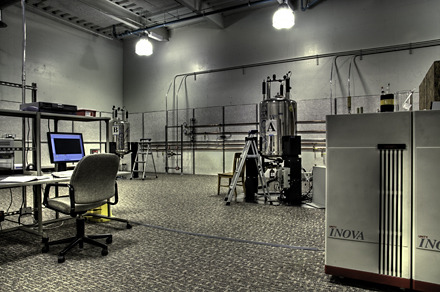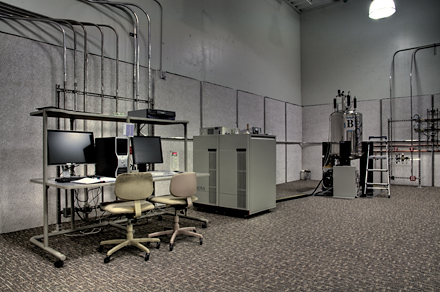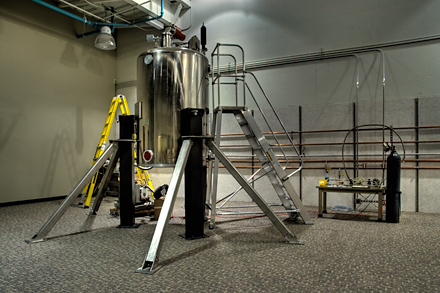Instruments
Agilent DirectDrive 500 (500a)
1H, 13C, 15N, 2H | VT operation: 5° to 40°C.
The 500a instrument was installed in May, 2012, and features a high-sensitivity cold-probe detection system that provide an increase of approximately 4x over the conventional room-temperature probe design. The 500a instrument is designed with application to biological macromolecules as its primary target, but is extremely useful in any applications requiring high-sensitivity detection of 1H and/or 13C resonances (e.g., low sample concentration).

Agilent DirectDrive 500 (500b)
1H, 13C, 15N, 2H 7Li, 11B, 14N, 19F, 31P | VT operation: -100°C to 80°C.
The 500b instrument was installed in October of 2011, and is equipped with a number of direct X-nucleus detection and indirect 1H-detection probes. The 500b instrument is an excellent general utility instrument that is capably of VT operation over the range from about -100°C to about +80°C.

Varian VNMRS 800 (dd800)
1H, 13C, 15N, 2H | VT operation: 5° to 50°C.
The dd800 instrument was installed in the summer of 2010 and is equipped with two probes, an indirect 1H, 2H, 13C, 15N probe that is most useful for study of biological macromolecules, and a direct X-low-band probe (1H-decouple) that is most useful for application in synthetic chemistry and materials science. This instrument has increased resolution and separation of signals that may be indistinguishable at lower fields.

Bruker Avance NEO 500 (neo500)
Prodigy probe: 1H, 19F, 31P-35Cl
The neo500 instrument was installed in early 2019 and is equipped with a liquid nitrogen cooled Prodigy probe that is roughly twice as sensitive as a conventional room-temperature probe on both channels. The high-frequency channel is tunable to either 1H or 19F, and the broad-band channel is tunable to frequencies between that of 31P and 35Cl. It also has a room temperature probe with a broad-band channel tunable to nuclei between 19F and 109Ag. This instrument is equipped with a 60-slot SampleXpress sample changer.
Bruker Avance Neo 300 (neo300)
Room temperature probe: 1H, 19F-97Mo
The neo300 instrument was installed early in 2019. This two-channel instrument features a probe that will detect 1H on one channel, and nuclei between 19F and 97Mo on the broad-band channel. This probe can perform a wide range of measurements including 19F {1H} and 1H {19F} experiments. The system also includes a 24-slot SampleCase sample changer.
Varian 400 (i400)
Solid-State NMR
The NMR Center is home to two older ChemMagnetics NMR solid-state instruments operating at 200 MHz (1H) and 400 MHz (1H). These instruments were installed in the late 1980’s but remain completely operational. Both systems support standard CP/MAS experiments with high power 1H and X-low-band operation. The instruments were designed to carry out magic-angle turning experiments that provide high-precision measurements of chemical shift tensors (e.g. slow-turning FIREMAT experiments), which can provide unique structural information.The 200 MHz instrument is equipped with probes that support 5 mm and 7.5 mm rotors with turning speeds of approximately 12 kHz and 7.5 kHz respectively. The 400 MHz instrument is equipped with a 7.5 mm probe that supports maximal turning speed of approximately 7.5 kHz. The emphasis of these instruments has been and remains magic-angle slow turning experiments in which rotational frequencies are typically less than 2 kHz. In February of 2009 a new digital console was added to the laboratory that provides access to the standard range of multidimensional/multinuclear CP/MAS experiments for the instrument operating at 200 MHz (1H).For consultation regarding solid-state NMR, please contact Peter Flynn, Director of the NMR Center, at paul.oblad@utah.edu.FIREMAT reference: Alderman, D. W.; McGeorge, G.; Hu, J. Z.; Pugmire, R. J.; Grant, D. M. Mol. Phys. 1998, 95, 1113
Additional information about major EQUIPMENT
Liquids NMR
NMR Center liquids instruments were all manufactured by Varian/Agilent and include one 500 MHz (1H) four channel (1H, 2H, 13C, 15N) spectrometer named 500a, one 500 MHz (1H) three-channel (1H, X-low-band, X-low-band, wherein X-low-band refers to all nuclei up to a resonance frequency of about 200 MHz, e.g., 31P) spectrometer named 500b, and an 800 MHz (1H) four-channel spectrometer named dd800. All instrument RF-consoles feature entirely digital receiver sections that eliminate virtually all of the inherent quadrature detection artifacts present in analog designs. The 500a instrument was installed in May, 2012, and features a high-sensitivity cold-probe detection system that provide an increase of approximately 4x over the conventional room-temperature probe design. The 500a instrument is designed with application to biological macromolecules as its primary target, but is extremely useful in any applications requiring high-sensitivity detection of 1H and/or 13C resonances (e.g., low sample concentration). The 500b instrument was installed in October of 2011, and is equipped with a number of direct X-nucleus detection and indirect 1H-detection probes. The 500b instrument is an excellent general utility instrument that is capably of VT operation over the range from about -100°C to about +80°C. The dd800 instrument was installed in the summer of 2010 and is equipped with two probes, an indirect 1H, 2H, 13C, 15N probe that is most useful for study of biological macromolecules, and a direct X-low-band probe (1H-decouple) that is most useful for application in synthetic chemistry and materials science.
Solid State NMR
The NMR Center is also home to two older ChemMagnetics NMR solid-state instruments operating at 200 MHz (1H) and 400 MHz (1H). These instruments were installed in the late 1980’s but remain completely operational. Both systems support standard CP/MAS experiments with high power 1H and X-low-band operation. The instruments were designed to carry out magic-angle turning experiments that provide high-precision measurements of chemical shift tensors (e.g. slow-turning FIREMAT experiments), which can provide unique structural information. The 200 MHz instrument is equipped with probes that support 5 mm and 7.5 mm rotors with turning speeds of approximately 12 kHz and 7.5 kHz respectively. The 400 MHz instrument is equipped with a 7.5 mm probe that supports maximal turning speed of approximately 7.5 kHz. The emphasis of these instruments has been and remains magic-angle slow turning experiments in which rotational frequencies are typically less than 2 kHz. In February of 2009 a new digital console was added to the laboratory that provides access to the standard range of multidimensional/multinuclear CP/MAS experiments for the instrument operating at 200 MHz (1H).
